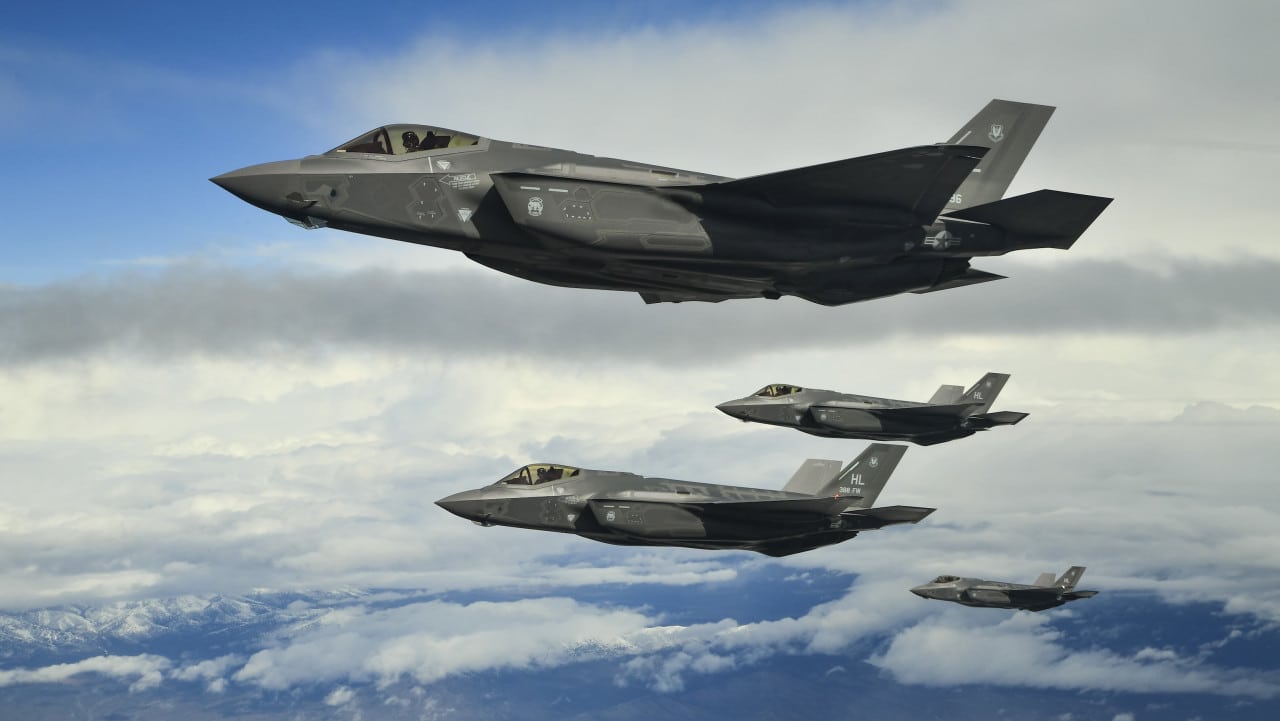
A squadron of F-35As flying over Hill Air Force Base in Utah. (Photo courtesy of U.S. Air Force)
Seven years ago, the F-35 Lightning II Joint Strike Fighter (JSF) program—the fifth-generation, multi-role stealth fighter—was close to being canceled. Now its creators are focused on changes for the next generation and dreaming up future technology that might be added to it down the line
In 2011, then-U.S. Defense Secretary Bob Gates put the bloated, over-budget and behind-schedule program on probation with two years to shape up before the U.S. government would cut its losses, and it could have gone either way, according to the program manager for the F-35’s drag chute system, Arthur Sheridan.
The Lockheed Martin fighter’s selling point is information. It’s supposed to give its team the upper hand by always having more information than the enemy thanks to its advanced sensor suite, ability to share information, low profile and ability to adapt to almost any situation with its three variants: the standard F-35A with conventional takeoff and landing capabilities, the F-35C which has larger wings with foldable tips and improved low-speed control for landing on aircraft carriers, and the signature F-35B with short takeoff and vertical landing capability.
None of that matters, though, if it’s too heavy to fly the way it needs to, said F-35 engineering project office Senior Manager Mark Counts at June’s AIAA Aviation Forum. Filling the jet so full created weight problems, restricting flight distance, speed and agility beyond what was acceptable, especially in the case of the F-35B. It also put too much stress on certain joints and rivets.
Lockheed Martin spent the two probationary years making over 600 changes to optimize size, weight and power, resulting in the shedding of 2,600 lb and a 700-lb thrust increase, according to Counts. That got the JSF back on track and, ultimately, off probation, if not the hot seat. Since then, Lockheed Martin and its myriad partners have been focused on keeping weight and costs down and quality up, and working back toward that promise of a flying do-it-all sensor laboratory.
Integral to that promise are the purported 9.1 million lines of code running under the surface of the F-35. Many of those direct the data fusion engine that connects all the powerful sensors the F-35 carries and combines everything into information pilots can use to get that crucial leg up on enemy combatants.
One of those sensors is the AN/AAQ-37 distributed-aperture system (DAS) produced by Northrop Grumman. It uses six electro-optical sensors that operate in the mid-wave infrared spectrum to provide a 360-degree view around the plane in an attempt to maximize situational awareness. It aids in missile and launch point detection and its cameras are integral to the helmet-mounted display system’s (HMDS) ability to let the pilot see through the plane.
That contract only extends through 2023, though. Northrop did not compete to keep producing the system, which Dixon described as “not being a good business case” for the company. Raytheon won the contract beginning with Lot-15 F-35 DASs, which Lockheed Martin’s Skunk Works head and former F-35 lead Jeff Babione said will have five times the resolution of the current DAS at a lower cost.
The DAS may also be the seed of a future technology Babione envisions for the F-35: the ability for the pilot to look wherever he or she wants and see a highly augmented version of what surrounds the fighter regardless of the canopy. He described that possibility at AIAA as a technology being worked on further afield than confirmed changes like AGCAS and the DAS switch.
The root of that may already be there, though. The DAS surrounds the F-35 with real-time cameras and, in the words of Lockheed Martin VP of F-35 Engineering and Technology Santi Bulnes, “the current HMD augments what the pilot sees with tactical symbology today no matter where he looks.”
It even works with two forward-facing cameras so that “with a press of a button, an IR image can also be displayed on the HMD which enables ‘looking through aircraft structure’ or augmented night vision,” according to Bulnes.
That technology is notably used to visually erase a portion of the front canopy bow that would otherwise block the pilot’s line of sight. Lemons said that “case of augmenting reality a bit to remove a piece of structure from the aircraft” could serve as a nascent version of what Babione discussed, which might expand on that with multi-spectrum vision.
It’s no sure thing, though. Lockheed would not confirm that technology as the future of the jet, and, in the words of the company’s mission systems expert for the F-35, Greg Lemons, “You don’t want to adopt something just because it sounds good. You want to be smart about the parts you bring in, and the parts that you decide aren’t really going to help us.”
The F-35 currently costs between $94 million (F-35A) and $122 million (F-35B) for low-rate initial production run 10, though sustainment cost projections are as big a concern as production costs for a program that is expected to cost $1.5 trillion over its 55-year lifespan. The unit prices are expected to continue to drop as the fighter enters full-rate production this year, and soon the overall price per jet is expected to drop below $100 million.
At the same time, Lockheed is shifting its focus from upfront development toward its continuous capability development and delivery (C2D2) strategy, which focuses on agile upgrades. That’s where things such as constant small software updates, additions when they’re ready such as AGCAS, and long-term planning for things like full augmented vision are all balanced to keep evolution and adaptation a constant.
This story is part of our expansive F-35 coverage. You can also learn about the fighter’s helmet-mounted display system, data fusion and information sharing, automatic ground-collision avoidance and its active electronically scanned array radar.